Background:
Routinely I’ve come across discussions about intercoolers that refer to the “volume” of the intercooler. A comment will be made along the lines of “with a greater power level a larger volume core is needed” or “X intercooler has a larger volume than Y intercooler”, implying that X is better due to the larger volume.
The use of intercooler volume as a predictor of intercooler core performance is a poor choice for a couple of reasons.
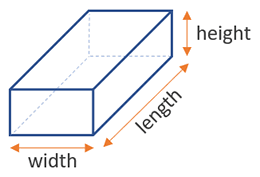
Analysis:
One issue with the way this measure is used is that in nearly every instance that I have seen it used it is based on the exterior dimensions of a rectangle, the IC core. This discards most all elements of the core design that have a direct contribution to how the intercooler performs.
A better approach is to measure the internal volume of the core. This can be accomplished by filling it with a liquid, such as water, and measuring the quantity that it takes to fill the core.
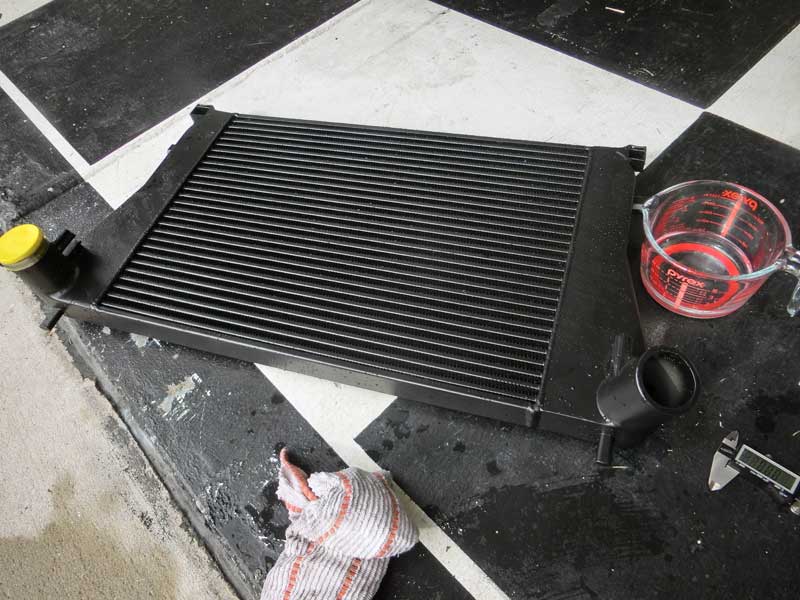
This will give a more accurate measure of the internal volume but is still inadequate since it includes the volume of the end tanks that do not aid cooling significantly.
Heat transfer from an intercooler can be calculated using the equation:
Q = U x A x DTlm
- Q is the amount of energy that is transferred.
- U is the heat transfer coefficient of the core.
- A is the heat transfer area – the area of the tubes and fins that are exposed to the outside (cooling) air.
- DTlm is the log mean temperature difference – the difference between internal and external temperatures.
Notably, the physical dimension that factors into heat transfer is the area, not volume. There is not a linear relationship between the volume and the area, for a given core volume the area could vary greatly.
Calculating the exposed area of a core is not an easy task, calculating the volume of a rectangle is fairly simple, this is probably part of the reason why volume shows up in discussions, despite being a poor attribute for predicting performance.
Example:
The significance of area versus volume as it relates to heat transfer was apparent during some research I did on a bicooler intercooler option.
A Precision Turbo and Engine intercooler was acquired as a candidate to use as a bicooler.

After a test fitting, I changed my mind and decided to go a different route. Before getting rid of the PTE intercooler it was flow tested and bench-tested for cooling performance.
Six months later I acquired the same PTE intercooler with the intent of picking up where things had left off.
By this time I had added a new variation to the bench cooling test that I’ve conducted and subjected the new PTE IC to the bench cooling test.

Compared to the previous test the results were significantly different:
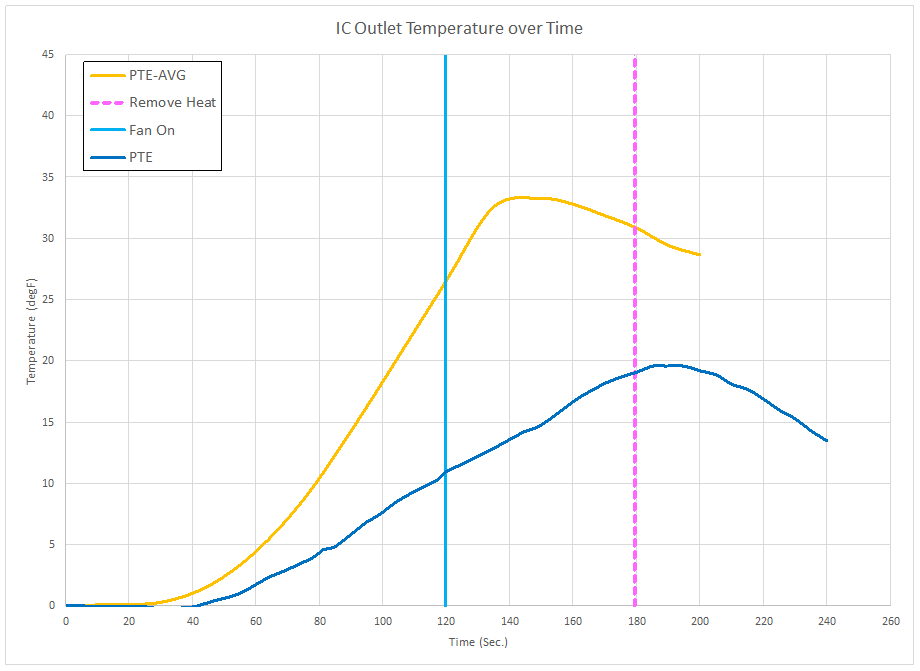
The new IC, shown with the orange line, heated up much faster than during the test six months prior, shown with the blue line.
Deducing that either something had gone wrong with the test, or there was a difference with the product, the new IC was subjected to a flow test.
The flow test has less chance for variability providing higher confidence in the results.

Again, compared to the previous test the results were significantly different:

The recently purchased PTE intercooler flowed substantially more air than the first product.
These two test results were consistent, a higher flowing core is likely to have reduced cooling capacity.
This led to researching photographs I had taken of the original IC to compare with the second IC.
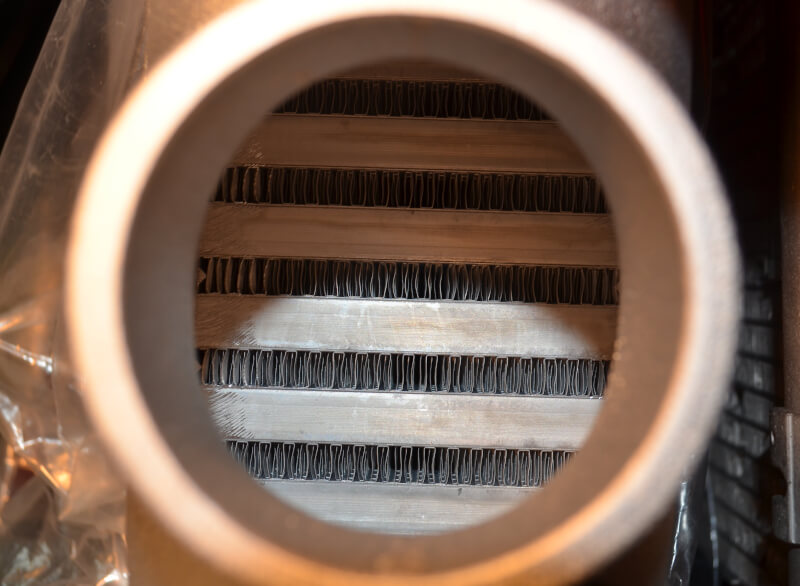


It was clear the interior design was different between the two cores.
Looking at the exterior:

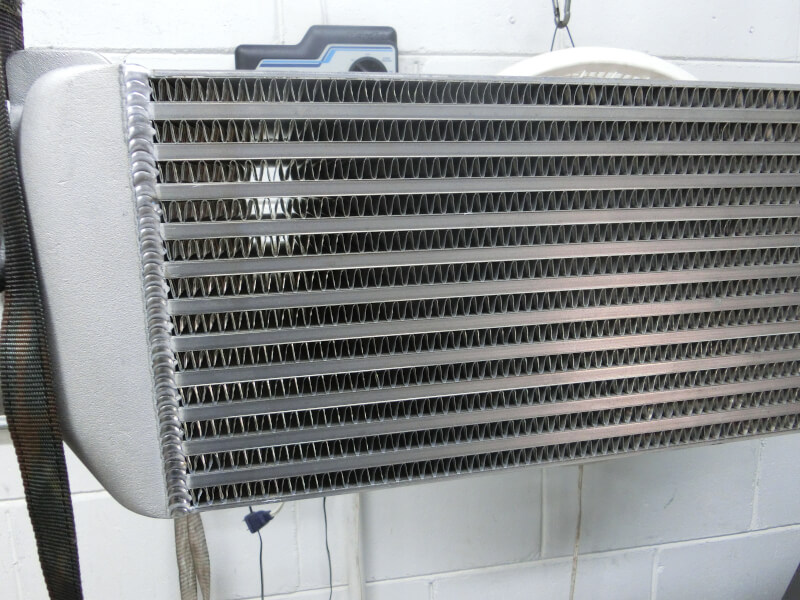

Differences in the exterior fins are also apparent.
The differences in the cores visually were consistent with the test results. The core with the higher exterior and interior fin density had a lower airflow and increased cooling.
Conclusions:
The same model PTE intercooler, with the same exterior core dimensions, thus “volume“, showed substantial performance differences on a flow and cooling test.
The differences in cooling and airflow are attributed to the exterior and interior fin designs.
Referencing intercooler core volume as an attribute that relates to intercooler performance is not recommended.

“These two test results were consistent, a higher flowing core is likely to have reduced cooling capacity.”
Do you mind expanding on this?
Removing heat from the air that is passing through the interior of the core is accomplished mostly by the fins that are within the tube passages. The more contact the air has with the fins the greater the heat transfer that can take place. The height of the fins, if they are offset, the thickness, and probably some other properties, will affect how effective they are at heat transfer. They can promote the mixing of the air, which also helps to get the heat out of the air and into the fins, so it can be removed from the IC.
The contact with the fins is an impediment to the airflow, creating back pressure, or pressure drop across the core, which reduces airflow for a given pressure drop. Flow bench testing takes places at a specific pressure drop, normally 28″ of H2O, and the amount of airflow that can pass at that pressure is measured. More airflow being better.
The internal fin design affects two results, heat transfer and airflow, in opposite ways. More fin area promotes greater heat transfer but hurts airflow. Less fin area reduces heater transfer but increases the airflow.
That’s just a generalization though, and with more effort put into the design an IC could transfer heat well and flow well, but it’s harder to pull off. So, my point was that measuring the airflow increase from one PTE core to the other, and seeing the cooling efficiency drop with the higher flowing core, was not an unexpected result.